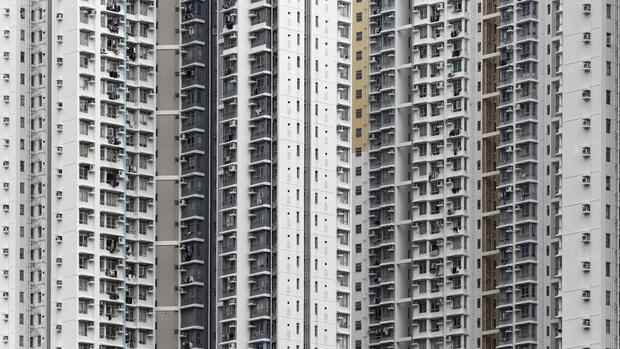Berlin The coalition has set itself the goal of providing 100,000 social housing units a year. But despite increased federal funding, social housing construction is not progressing. In 2021, just under 21,500 new social housing units were built. Due to expiring price controls, however, the total number fell to 1.1 million nationwide. 20 years ago, the stock was around 2.6 million social housing units.
Now the alliance of associations “Social Housing” is sounding the alarm: Without further financial aid, social housing will experience a “radical crash” in 2023, according to the alliance, in which the German Tenants’ Association and IG Bau, among others, have joined forces. The federal and state governments would have to provide funding of at least 12.5 billion euros for 2023. There is no other way to achieve the goal set by the federal government of 100,000 newly built social housing units per year.
The demand overshadows previous calculations: as recently as January, i.e. before the start of the Russian war of aggression against Ukraine, the alliance had demanded five billion euros in subsidies a year.
The federal states are actually responsible for the promotion of social housing. However, the federal government can grant them earmarked funds. For the current year, the federal government is providing two billion euros.
Top jobs of the day
Find the best jobs now and
be notified by email.
In addition to one billion for social housing, there is also the so-called climate billion for the energy-efficient refurbishment of social housing. Overall, the financial planning provides for 14.5 billion euros for social housing up to 2026.
Alliance criticizes “construction lethargy”
For Minister of Construction Klara Geywitz (SPD), the topic is at the top of her list of priorities. Almost like a mantra, she repeats the new building goals at each of her appearances. In an alliance for affordable housing, she is currently discussing how more affordable housing can be created together with representatives from the federal states and municipalities, the construction and housing industry, private landlords, tenants’ associations, trade unions and environmental organizations.
For the building ministers, social housing is at the top of their list of priorities.
(Photo: Reuters)
There is no way around the fact that the federal and state governments will have to dig much deeper into their pockets than before to create new social housing, explains the alliance, which refers to a special study by the Pestel Institute on behalf of the associations: The clear higher state subsidies – with a subsidy of at least 125,000 euros per social housing – are necessary, above all, to absorb price increases and rising building interest rates.
Likewise, to counter further uncertainty in the market. According to the research institute, it is now important to revitalize the social housing construction that has been particularly affected by the “construction lethargy”.
Even municipal, cooperative and church housing companies have stopped most of their construction projects: “They put almost everything that was still in the planning stage on hold,” says the head of the Pestel Institute, Matthias Günther.
In the past year alone, arithmetically, a social housing disappeared from the market every 19 minutes: “Their number fell by almost 27,400 to just 1,101,500 social housing nationwide,” says Günther.
>> Read here: Converting the heating system for the heat transition – what obligations homeowners have
Günther advocates making the federal states more responsible and increasing their share of subsidies for social housing. Because: “If the state share of only 23 percent in funding remains, then the federal government alone will have to provide between 9.6 and 11.7 billion euros for social housing for its 2023 budget – depending on the energy saving variant. Provided he sticks to his self-imposed target of 100,000 newly built social housing units per year,” said Günther.
The stock of apartments in social housing has been falling for years.
(Photo: dpa)
The annual target of 100,000 newly built social housing, which the federal government set itself at the beginning of the election period – namely at the end of last year and thus before the crisis – threatens to become a “traffic light illusion”. “In order to save what can still be saved, the federal government must mobilize all its reserves,” warns the scientist. Social housing must be put in a position to absorb the capacities that housing construction as a whole is gradually freeing up.
Price increases, interest rate increases, delivery bottlenecks
Increasing prices for building materials and building land, rising interest rates, imminent supply bottlenecks for building materials, plus the general uncertainty of a crisis: more and more private builders, housing companies, investors and project developers have begun building plans disappearing into drawers again. “The building climate is worse than it has been for years. The danger now is that construction will reduce capacities and, above all, lose skilled workers. That would be fatal. Because once you turn your back on the building, you won’t come back so quickly,” explains Günther.
Increasing prices for building materials and building land, rising building interest rates, impending supply bottlenecks for building materials are having a negative impact on the building climate.
(Photo: dpa)
He also called for two special building programs, one for converting offices into apartments and one for adding roofs. According to the Pestel Institute, up to 1.9 million new apartments could be created just by converting office space that would no longer be needed due to the establishment of home office.
Adding a storey to the roof of residential buildings built in the post-war period up to the end of the 1990s also offers enormous potential: Günther said that around 1.5 million new apartments could be created here with on-top floors alone. “Both the office conversion and the addition of a storey require significantly less building material and are therefore significantly cheaper than any new building.”
More: “The federal government acts completely irrationally” – The construction of cheap apartments threatens to fail
